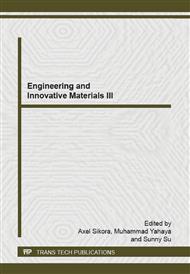p.159
p.165
p.175
p.180
p.184
p.189
p.193
p.198
p.204
Hydrophobicity Characterization of Bio-Wax Derived from Taro Leaf for Surface Coating Applications
Abstract:
The hydrophobic properties as well as the presence of 1-octacosanol of taro wax extracted from taro leaf were investigated using various analytical techniques. The bio-wax extraction was achieved by immersing taro leaves samples in 500 mL chloroform at 50°C for 30 seconds and the step was repeated for the same sample using fresh chloroform. The solvent was evaporated using rotary evaporator and the raw bio-wax solution was obtained. Hydrophobicity test showed the average time for the test was 981s which exceeded the 300 s limited for hydrophilicity. TGA results indicate the existence of multi-components in taro wax with the decomposition occurring at three stages. The DSC result showed that the taro wax is composed of at least two contents, ie lower content with smaller melting point range of 50 to 60°C as well as upper content with higher melting point range of 65 to 75°C. Contact angle of droplets of distilled water on the taro wax surfaces were found to be greater than 900 and this confirmed its hydrophobic property. The n-octacosanol presented was identified through FTIR and GC-FID analyses. The functional compounds OH, CH3, CH2, and C=O were detected. From the GC-FID, the n-octacosanol was presented at 34.5 min compared to the standard solution. Plant base taro wax can be a source of sustainable and renewable hydrophobic material for use in HVAC application system.
Info:
Periodical:
Pages:
184-188
Citation:
Online since:
October 2014
Keywords:
Price:
Сopyright:
© 2014 Trans Tech Publications Ltd. All Rights Reserved
Share:
Citation:


